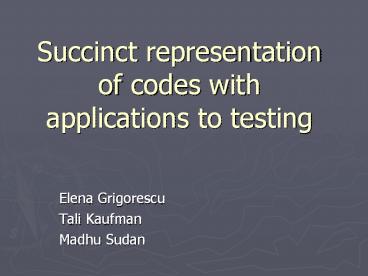Succinct representation of codes with applications to testing PowerPoint PPT Presentation
Title: Succinct representation of codes with applications to testing
1
Succinct representation of codes with
applications to testing
- Elena Grigorescu
- Tali Kaufman
- Madhu Sudan
2
Outline
- Testing membership in error correcting codes
- Sufficient conditions for testing algebraic codes
- Possible promising perspective rich group of
symmetries of code - Our result affine/cyclic invariant, sparse codes
can be described succinctly by a single, short
codeword - Implies locally testability results
- Proof sketch
- Conclusions
3
Locally testable codes
0 1 1 0
C
C
C satisfies Code Linear
4
Testing linear codes via duality
- BHR Test for linear properties are essentially
- of the form
- Given x, pick
- Accept iff
- Locality of test
- Dual-distance smallest weight of a codeword in
dual-C
5
Sufficient conditions for testing
- Necessary condition for local testing (linear
codes) - - small dual distance
- - not sufficient( BHR show random LDPC
not locally testable) - Sufficient conditions
- - Possible approach nice symmetries of code
- C is invariant under permutation
iff
6
Symmetries and testing
- Many known testable codes have somewhat large
symmetry groups - Eg. Linearity invariance under general linear
group - Low degree, Reed-Muller, BCH invariance
under affine group - Specific sufficient condition
- KS affine invariance local
characterization imply testing - AKKLR Conjecture 2 transitivity small dual
distance - Falsified in general GKS
- Modified AKKLR Question What if dual code is
generated by single low-weight codeword and its
shifts under some group G (Single-Orbit Property
under G) - Are these codes testable (for some group
G? for all groups G?)
7
Single orbit property under affine
invariant/cyclic groups
- Affine group
- Cyclic group
- C has single orbit under cyclic group
- w01001 then B01001, 10100, 01010, 00101,
10010 is a basis for C - Formally, C has k-single orbit under G ( included
in Aut(C) ) if
8
Our work
- Study Single-Orbit Property of common codes.
- Def C is sparse if it contains a poly number of
codewords - Duals of binary sparse affine invariant codes
have the single-orbit property under affine group
- - under some block-length
restriction n prime - - KS08 Single-orbit codes under affine
group are testable. - Duals of binary sparse cyclic invariant codes
have the single-orbit property under cyclic group
- - under more block-length
restrictions n, N-1 primes - - No testing implications
9
Related works
- Sparse, large distance codes are testable
- KL, KS ( tests are coarse, unstructured)
- Affine/linear invariant characterization
imply testing - Here sparse
large distance - affine invariance
characterization (explicit tests) - KL dual-e-BCH codes are testable (unstructured
tests) - e-BCH are spanned by shortest codewords
- Here dual-e-BCH are spanned by a single, short
codeword (explicit basis / tests)
10
Toward an explicit description of binary affine
invariant codes
- Affine invariance
- Any function is of the
form - The Trace function
11
Explicit description of sparse affine families
- Let
- - What aff inv families does f belong to?
- Consider the binary rep of degrees 1, 111,
1100, 10011 - Then
- In general if degree d occurs then its shadow
occurs - Sparsity translates into few monomials
- Affine/Cyclic codes are described by a small set
of degrees
Shadow(10011) 10011,10010,10001,10000,11,10,1
12
Proof ingredients
- Strong number theoretic result of Bourgain
implies high weight of functions of the form - few degs gt
deglt
Degs inside trace
0
?
Weil bounds
Bourgain
13
Proof ingredients (contd)
- MacWilliams type counting estimates
- - fourier transform between the functions
that represent number of codewords for each
weight in C and in dual- C, respectively - For sparse codes of length N and of high
distance obtain
14
Proof sketch
- C described by set of degrees D
- Let dual-C Span( aff(w) )
- If C C then there exists
- Let
- Associate C(a) to codew. w
- Does every wtltk codew. belong to a dual of some
C(a) ? - New goal exists w that does not belong to the
dual of any C(a), for all a - We show
Want exists codew. c with wt lt k s.t.
Span(aff(c))Dual-C
Dual-C
C
C(a)
C
w Dual-C
15
Proof Sketch
- C, C(a) sparse, high dist (Bourgain) (assuming
N-1 and n are primes) - How many codew of wt k in dual-C?
- How many codew of wt k in dual-C(a) ?
- Total number of degrees a to consider N/n
- Therefore, there exists codew. of wtltk in dual-C
that whose orbit generates C
16
Specifics of the affine case proof
- Here only assume n prime- Bourgain doesnt hold
for all monomials - Need codes C(a) to have deg a lt
- Use shadow property
- Show that enough to consider a in the set
17
Cyclic codes
- Invariant under
- Punctured affine invariant codes are cyclic
- Cyclic codes are described by generator
polynomial (or its roots in the field) - Alternatively described by function families of
the form - Degrees can be arbitrary
18
Single orbit affine vs cyclic codes
- Affine (length N )
- n prime
- degrees of monomials are shadow closed
- Aut(C)
- single orbit implies testing
- Cyclic (length N-1)
- n, N-1 primes
- degrees of monomials are arbitrary
- Aut(C)N
- not known if single orbit implies testing
19
Open Questions
- Do same results hold for non-prime n,
? - Single orbit under what other groups imply
testing? How large does the Aut group should be
to imply testing? - Small weight basis invariance implies testing?
- Examples of families where the tests are not the
expected ones (I.e. not the ones suggested by
the description of Aut group)
20
Thank you

